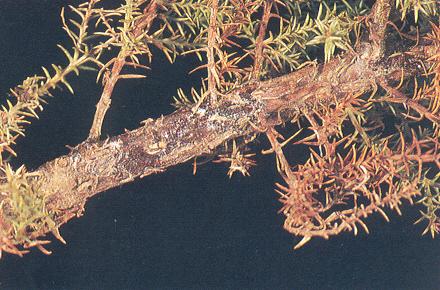PESTS AND DISEASES OF FORESTRY IN NEW ZEALAND
Cypress canker - nursery disease
From Forest Pathology in New Zealand No. 16. Nursery diseases.
Based on Margaret Dick and AL Vanner (1986),
Revised by MA Dick (2008).
Causal organisms: Seiridium cupressi (Guba) Boesewinkel (Lepteutypa cupressi (Nattrass, C. Booth, & B. Sutton) H.J. Swart; in this country previously called Seiridium unicorne (Cooke & Ellis) B. Sutton = Monochaetia unicornis (Cooke & Ellis) Saccardo).
Seiridium cardinale (W.W. Wagener) B. Sutton & I.A.S. Gibson (= Coryneum cardinale W.W. Wagener).
Type of injury
Branch death, or mortality of seedlings if infection occurs low on the stem.
Diagnostic features
- Resinous areas, often swollen, on stems and branches, that may develop into cankers (Fig. 7).
- Dieback of terminal and lateral shoots.
Hosts
Chamaecyparis lawsoniana‡, Cryptomeria japonica*, × Cupressocyparis leylandii‡, × Cupressocyparis ovensii†, Cupressus arizonica†, Cupressus goveniana†, Cupressus lusitanica†, Cupressus macrocarpa§, Cupressus sempervirens‡, Cupressus torulosa†, Calocedrus decurrens†, Juniperus communis*, Sequoiadendron giganteum*, Thuja occidentalis†, Thuja plicata.
*Rare occurrence with negligible damage.
†Low susceptibility.
‡Moderate susceptibility (for C. sempervirens, based on overseas reports).
§Very susceptible, especially in young plantations less than 10 years old.
Distribution
Seiridium cupressi is more common than S. cardinale, though both fungi are found throughout New Zealand. The incidence and impact of the disease intensify as the mean temperature increases, making it more prominent in Northland and Auckland.
Disease development
This disease is unusual in that two different fungi cause identical symptons. Initial infection by these fungi commonly occurs at the base of a branchlet, though it may occur through wounds on any part of the seedling. The infected tissue turns brown, and large amounts of resin are exuded. Fading and death of foliage follows girdling of the affected branches. Small black pustules, in which the spores are produced, appear on the surface of the dead tissue. Spores are spread by water splash. Diseased trees neighbouring the nursery are the most usual source of initial inoculum.
Economic importance
Generally, the disease is of little importance in nurseries. However, if there is a nearby inoculum source widespread infection may occur, leading to considerable damage
Alternatively, infected seedlings may not develop severe cankering until they are planted out in the field.
see Cypress Canker: Forest Pathology in New Zealand No. 8:
Control
Good control has been obtained overseas by monthly spraying in spring and summer with 4kg of Copper Oxychloride 50WP (500g/kg copper oxychloride) and 10 litres of surfactant in 1000 litres of water per hectare. In New Zealand copper is applied at a lower rate e.g. 1kg Copper Oxychloride 50WP in 500 titres of water per hectare.
Removal of infected seedlings is the best means of checking the disease. Strict nursery hygiene should be practised and all infected material burnt. Cypress trees close to the nursery should be examined for infection and infected trees removed if the nursery intends to continue producing cypress stock.
As a precaution against planting out diseased stock, trees should be examined before leaving the nursery so that any trees with symptoms of cypress canker can be destroyed.

Fig. 7 – Resinous exudate on stem of Cypressus macrocarpa seedling infected with Seiridium cupressi
Bibliography
Hood, I.A.; Gardner, J.F.; Kimberley, M.O.; Gatenby, S.J.; Cox, J.C. 2001: A survey of cypress canker disease. New Zealand Tree Grower 22: 38-41.
Van der Werff, H. 1984: Cypress canker in New Zealand plantations. New Zealand Journal of Forestry Science 18: 101-108.

 Farm Forestry New Zealand
Farm Forestry New Zealand

